Farmer Profiles
We will feature different farmers discussing their nutrient management efforts around their farm to feature innovative, creative, and high quality practices. As a way to increase the networks and engagement around nutrient management, farmers can volunteer to be a resource to people looking for more information on their practices.
These profiles do not serve as UC recommendations. Rather, they illustrate how different farmers throughout the state regard nutrient management as part of their overall farm management.
Farmer Profiles were created with the help of the Community Alliance with Family Farmers.
Mark Mason - Huntington Farms
Mark Mason is the manager for Huntington Farms, a third-generation family business in the Salinas Valley, responsible for farming head and leaf lettuce, cauliflower, celery, and broccoli on 4000 acres of land in the Soledad-Salinas area. The fields are generally double cropped per year. He has been at his current position for six years and has worked in other cool season vegetable production enterprises in California before that.

For the last 2 -3 years Mark has been working with Michael Cahn, UC Cooperative Extension Farm Advisor in Salinas, to implement CropManage, an on-line irrigation and nutrient management tool. CropManage has been developed by Michael Cahn to improve water management and match nitrogen (N) applications to crop N uptake. The web application uses the soil nitrate quick test results and weather-based irrigation scheduling, in addition to site and planting specific information, as data inputs and allows managers, irrigators, and fertilizer staff to allocate and coordinate resources with the goal of minimizing potential leaching losses of nitrate.
Nate Ray - De Jager Farms
Nate Ray is the general manager of DeJager Farms Inc., responsible for producing forage feed for 8 different diaries with a total of 25,000 cows on 17,000 acres of land near Chowchilla. About 8000 acres are in alfalfa, another 8000 in a corn-wheat rotation, and “since enough forage is produced for the dairies,” 1000 acres are inalmonds and tomato.
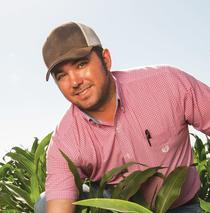
Nate’s interest in minimum tillage has its origin in the friendship with a neighbor who went to school in the Midwest where he was exposed to conservation tillage practices, implemented there primarily to control erosion.
Tom and Dan Rogers Almond Orchard
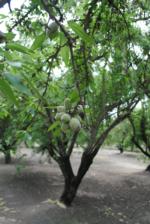
The farming philosophy of the orchard is simple: take care of the soils and they will take care of the trees. To that end, Tom and Dan collect various data and monitor their soils and plant nutrient status to inform their irrigation and nutrient management programs. They believe strongly in protecting their natural resources and supporting the environment to produce healthy trees and quality almonds.
Scott Park Farming
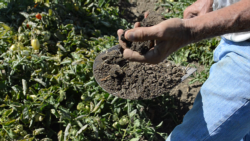
Today, Scott’s main farming philosophy and approach to nutrient management is simple: "100% respect for the soil." Scott’s gears his practices towards keeping the soil healthy to support crop growth, increase water holding capacity and infiltration rates, and increase soil fertility. The nutrient management plan at Park Farming is based on rotational cropping, cover cropping, incorporating crop residue, and using organic soil amendments.
John Texeira - Lone Willow Farm
John Teixeira farms 90 acres of land bordering the San Joaquin River in Firebaugh, California. The land has been certified organic since 1991. One field also carries biodynamic certification, which will soon extend to the entire farm. The farm has evolved from producing organic cotton, heirloom tomatoes, and basil in the early years, to now focusing on producing pastured pigs, goats, and chickens in rotation with livestock feed, including alfalfa and corn.

Frank Muller - Muller Ranch
The Muller Ranch (M Three Ranches), grows organic and conventionally managed tomatoes, peppers, cucumbers, sunflower, walnuts, almonds vine grapes, olives, alfalfa, squashes, millet, wheat, corn, safflower, canola, and garlic on several thousand acres in Yolo County, where Joe Muller & Sons, as the family enterprise was formerly known, was founded in 1967.

Paicines Ranch Vineyard
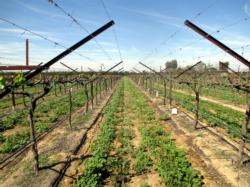
|
Paicines Ranch, located south of Hollister, has been operated since the mid-19th century and was purchased by Sallie Calhoun and Matt Christiano in 2001. It consists of 7,600 acres in total, which is divided between 570 acres of farmland and the rest grazing land. The grazing land is now primarily leased to Joe Morris of T&O Cattle Co./Morris Grassfed Beef, which markets grassfed beef directly to the public. Paicines Ranch is managed by Kelly Mulville, who is a Certified Educator with Holistic Management International (HMI), and also a UC Santa Cruz Farm and Garden graduate.
Paicines Ranch’s irrigated bottomland was previously farmed by Earthbound Farms, but the ranch has taken it back and is currently restoring the soils through cover crops and planned grazing. They plan to incorporate a larger variety of crops into their production, resulting in a polyculture of fruit and nut trees and vegetable crops.
Full Belly Farm - Diversified, Organic
Full Belly Farm is a diversified organic farm in the Capay Valley that produces over 80 different crops, from 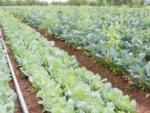
Cover crops and compost provide the foundation for nutrient management at Full Belly. As Paul Muller explains, “We’re harvesting energy from the sun. The more we can keep plants growing in the ground, the more energy we can harvest.”
Charlie Starr Vineyards
Developing a nutrient management plan for grapevines requires testing vine nutrient status and understanding the nutrient requirements of the plant. Like most plants, grapevines take nutrients from the soil based on the stages of their development, and nutrient uptake curves have been developed to assist growers. By comparing the nutrient needs of the plant based on development stages with the results of the petiole samples from the vineyard, Charlie creates a nutrient management plan to provide the grapevines with the right amount of nutrients at the right time.
By matching his irrigation schedule to the evapotranspiration of the vines, and by using petiole samples and the nutrient uptake curves of the vines, Charlie is able to optimize his applications of nutrients and water to make sure that water and nutrients are staying on farm.
